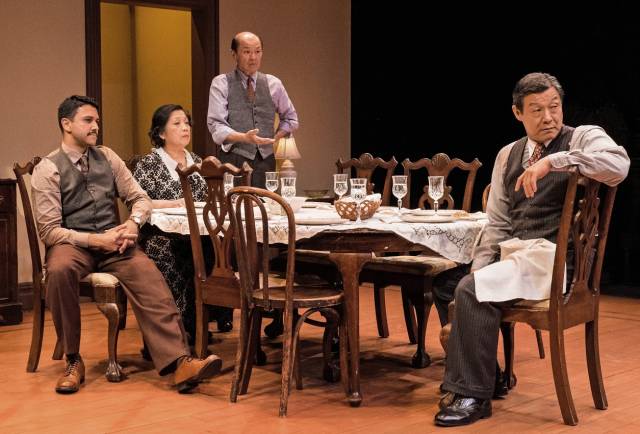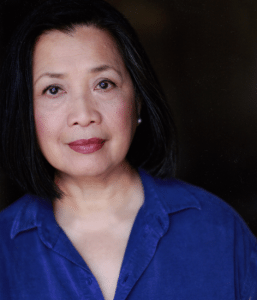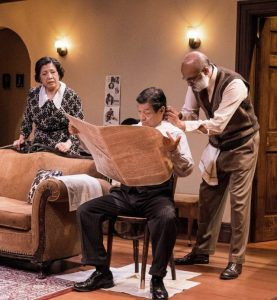

Now in its 24th season, the National Asian-American Theater Company (NAATCO) is presenting Awake and Sing!, Clifford Odets’ Depression-era play about the Bergers, a Jewish family, living in the Bronx and contending with financial hardship and each other’s irritating personalities. As matriarch Bessie Berger, Mia Katigbak is perhaps the best demonstration of the validity of NAATCO’s mission to “reach across ethnic boundaries to illuminate abiding characteristics of human nature.” She is a meticulous and talented actress committed to proving that Asian-Americans can be completely convincing playing roles that theatrical convention does not expect them to; she has carried out her commitment with respect for Odets’ work, with attention to cultural detail, and with hope that she will change the minds of her audiences.
I’m Jewish and I have a Jewish mother. I don’t know how you captured the physical mannerisms of the Jewish mother without being present during my childhood. I was really wondering what you did to prepare for that kind of mimicry.
Well, it’s an interesting thing. I didn’t want to mimic. And it’s part of Odets’ brilliance as well. The woman is not alien to me. In so many ways she’s similar to a lot of strong mothers I know. Or willful mothers. Or women who are under very, very specific directives of survival. And who can seem very overbearing.
One of the things that really worried me when we started -- I told this to my director [Stephen Brown-Fried] -- was that I wanted to make sure that we do justice to Odets’ language. And so we got a dialogue coach. Also, my mother’s partner for a long, long time was a Jewish man from the Bronx. And he used to read to me with a total Yiddish inflection – so that was kind of in my ear. And what I started to discover is that when you vocalize, it becomes a part of your body and the dialect and the language – along with the “type”, so to speak, which was very familiar to me -- it kind of all started to click somehow. And I live in New York, you know!
So you have a wealth of encounters to draw on.
Right.
 I was wondering, when you were working on the play, did feel that you had to get the Jewish characteristics and mannerisms exactly right or else the point you were trying to make would not have credibility?
I was wondering, when you were working on the play, did feel that you had to get the Jewish characteristics and mannerisms exactly right or else the point you were trying to make would not have credibility?
I would say we were very concerned about that but no more than we would be if we were doing a Chekhov or a Lorca. No matter what it is we do, it has to be related to the playwright’s intent. And especially with someone like Odets, who is on the contemporary end of the classical canon, it’s true -- a lot of people were very, very skeptical about the experience. I didn’t want to have to go the route of saying that there were Chinese Jews who existed. There’s a village in China, and it doesn't take a stretch of the imagination to figure out what would have happened to them had they emigrated here and ended up in the shmatte business and were living in the Bronx. Who’s to say they wouldn't have sounded like we sounded and looked like what we looked like?
There’s that aspect of it, but I think the more important thing is this: I don’t know how many times we’ve received a comment saying, “This is just like my family,” from both Jews and non-Jews alike. Which for me is a very, very gratifying thing to hear. People say, “Oh my god, I was watching it, and I was looking at your character, and I thought, ‘There’s my grandmother.’ ” Then they’ll look again, and say, “It can’t be my grandmother. But it is my grandmother.’ “ Grappling with those things is, I think, a very important. It’s something that I’d like our audiences to deal with, because then I think it should naturally flow into the question of – “Oh, maybe the way I see people could stand some scrutiny.”
It sounds like there is a kind of magic eye experience, where an audience member is transported seamlessly back to their childhood in one moment, but in the next, they’re making connections between the Asian-American actors on stage and the Jewish roles that they’re playing. Do you feel you’re doing both – being the Jewish family to the point where I feel like I’m watching Jews, but also reminding me of how Asian and Jewish cultural themes converge?
Yeah -- It becomes its own particular unique experience when you’re sitting there and having those two lines of thought. You know, we had a talkback last night, and somebody said there were several incidents in the play that were jarring for her, and I thought, “Well, that’s kind of cool and Brechtian, in a way.” There are times when you have to remove yourself from identifying with these people, so that there is a possibility for reflection about what it is you’ve just witnessed.
When you won an Obie Award for Awake and Sing! in 2014, you said, in reference to your very few detractors, something like -- of course, it’s so hard to imagine that an immigrant family dealing with familial, social and economic difficulties could possibly play…an immigrant family dealing with familial, social, and economic difficulties. To which I say, Uh, yeah. What do you say to people who are somehow still skeptical?
That reaction surprised me. In 2013, for the most part, we had very positive to excellent reviews, but there were a couple that bothered me, where an audience member would say, “I just don’t buy this. They’re all different Asian cultures, so how can they possibly be a family?” And that bothers me because for one thing, theater is the realm of the imagination. There are a lot of things that are hard to believe in real life that we buy when we see them on stage. So for me, that objection really points to the bane of our existence as Americans, which is the racism that’s inherent in the feeling behind, “I just don’t buy it.” In other productions, where you have Irish-Americans and Russian Jewish-Americans, that never comes up. You never hear, “I don’t buy that this is a family,” even though you have myriad cultures represented by the actors on stage.
So that became a very curious thing for me. My expectation is that people will always enjoy good theater and because Asian Americans are performing a culture that is not Asian American, I expect that people will mull that over and think about what it is that feeds into our racism. I think a lot of people who don’t even believe that they are [racist] will find themselves getting uncomfortable about this kind of stuff - and that’s just kind of a good thing to go through if you want to be a good human being. The one thing that I didn’t expect was, “We don’t buy it,” because of the way the actors look, basically, which is really the most minor reason for you not to buy it.

What do you think about that complaint -- that your cast is not ethnically homogenous, and therefore are hard to accept as members of the same family?
Well, in the 21st century, it’s very conceivable to me that these people are part of the same family, despite the fact that we look like we’re from different cultures – that’s just what the world looks like now. In my family, one of my maternal aunts married a white man, a German-American, and their daughter looked like a little Japanese doll. She grew up in Kentucky, so she had a Southern accent and her brother looked Aryan, and they were brother and sister. And that was thirty years ago! I’m like, whoa, man, you’re behind, in terms of what happens on stage. I did Scenes from a Marriage, and I went up at closing night and said to Ivo Van Hove, “Thank you so much for casting me, because I’m playing the mother of a woman who’s the daughter of a white woman and an African-American man.” And he kind of looked at me funny, like, “What’s the big deal?" And I thought, “Oh, of course you don’t think it’s a big deal; you’re from Amsterdam!” And it’s so embarrassing that here it’s such a problem.
I can imagine how some people would say that they thought the production was good – i.e., as convincing, as if white people were playing Jewish Americans – and therefore ignore your social message while appreciating your artistry, though in reality they go hand in hand. What do you think of that kind of reaction?
I think, hopefully, the experience plants a seed in the audience, even in skeptics. If there’s a circumstance in the future where such a person is confronted with a situation where they have an expectation of how somebody might sound or behave based on what they look like, hopefully they will think back on their experience of the play before they leap to judgment. The really idealistic hope is that we’ll stop the tactic of profiling, and, more bluntly, prejudice and stereotypes.
I know you were committed to get the play’s details exactly right for artistic reasons, but were you also reluctant to change any details in the play because of the cultural points you’re making? If you had, say, moved the Berger family to Flushing, people might have said that what made it believable was the change of location. Did you keep everything the same to prove you could do the exact play, with no edits or additions, and be fully convincing?
Yes, I think so. I always say – re-set it however you want to re-set it, as long as it makes sense and you can explain your choice, but try not to set a production that’s not originally in Chinatown there or in some other Asian cultural context, because, though that’s legitimate, that’s also the usual way that people will accept our doing the canon.
It would have been too…acceptable.
Yeah, that’s been done, successfully and interestingly, but it’s not what we do.
It as a great moment when you had James Saito, who plays Uncle Myron, use the slur, “Japs”, which was in the original play. He sold it – I think an impressed mutter ran through the audience, because you left that epithet in, and you didn’t cut it from the play despite the fact that an Asian-American actor had to say that word.
It’s interesting that, right after World War II, there were a lot of similar sentiments, instances of cognitive dissonance from the Filipinos, who had been occupied by the Japanese. If you’re Filipino, and you lived under Japanese occupation in that time period, you have lived through experiences that were probably culturally challenging for you, and we relish those challenges, we think they’re rich with questions we should all think about.
I do think NAATCO approaches those challenges with a lot of integrity – you put on an intellectually formidable production, and I hope your message gets through.
Thank you. It’s a lifelong struggle.
Awake and Sing! plays at the Public through August 8.